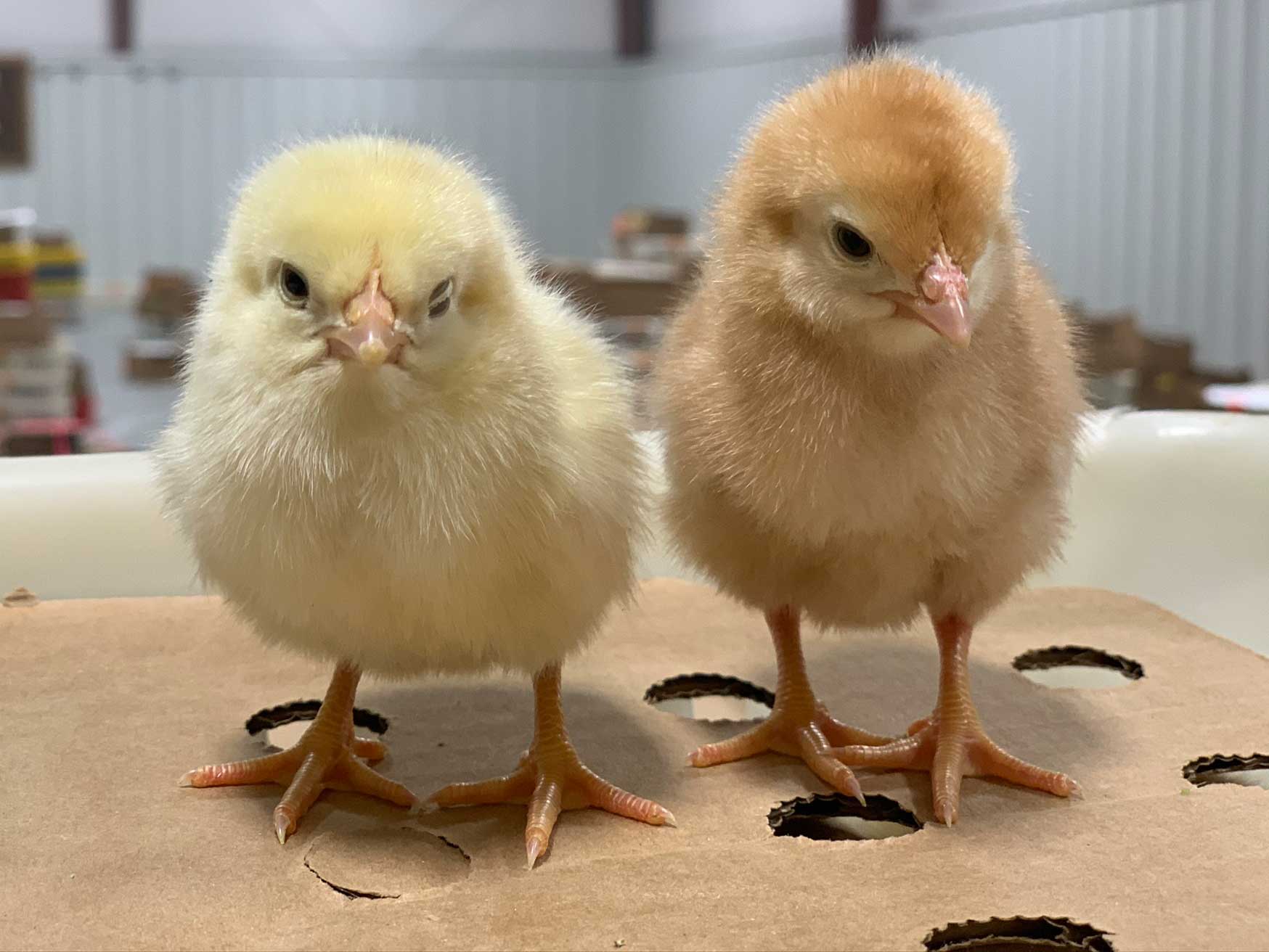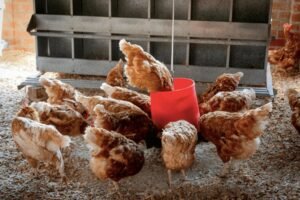Bringing home new day-old chicks is an exciting time, but the first 24 hours are critical. Knowing how to spot the difference between a healthy, vigorous chick and a poor-quality one can save your entire flock from a disastrous start. This guide gives you the exact checklist commercial hatcheries use, covering everything from the ideal brooder temperature for day-old chicks to the best feed for day-old chicks, providing in-depth advice to ensure your flock gets the best start possible.
Key Things to Know
- Healthy Signs: A healthy day-old chick has bright, open eyes, a closed and clean navel, dry and fluffy down, and stands on straight toes. They should be active and alert. Use a chicken health check as your baseline exam.
- Brooder Temperature: The ideal temperature for the first week is 92–95°F (33–35°C), measured at chick height. Watch their behavior—huddling means they’re cold, while panting means they’re too hot.
- Normal Weight: A chick’s weight should be about 67% of the egg it hatched from. A key performance goal is for them to multiply their hatch weight by at least 4 times within the first 7 days.
- Best Starter Feed: Layer chicks need an 18–20% protein starter feed. Broiler (meat) chicks need a higher protein starter, around 22–23%. You must match the feed’s medication status to the chicks’ vaccination history. Refer to our bringing chicks home checklist for a full list of must-haves.
Before Your Chicks Arrive: The Pre-Launch Checklist
A successful start begins before the chicks even arrive. Having the brooder completely ready creates a stress-free transition. Your goal is to have their new home warm, safe, and fully stocked at least 24 hours before you bring them home.
Set Up and Test Your Brooder
- Assemble the Brooder: Choose a draft-free location and decide on the best place to put your chicken coop for the long term. Use a stock tank, a large plastic tote, or a sturdy cardboard ring (often called a brooder guard) to create an enclosure. Ensure it’s large enough to prevent overcrowding and has rounded corners to stop chicks from piling up and suffocating.
- Add Bedding: Lay down a 3-4 inch layer of absorbent bedding. Pine shavings are an excellent choice. For the first day or two, cover the shavings with paper towels to prevent chicks from eating the bedding and to make it easy for them to find their food.
- Install the Heat Source: Securely set up your heat source. Brooder plates are the safest option. If you must use a heat lamp, ensure it has a protective cage and is double-secured with chains, not just the clamp, to eliminate fire risk. Check out our poultry equipment price list to compare costs.
- Preheat and Monitor: Pre-heat the brooder 24–48 hours before arrival; place a thermometer at chick height to verify 92–95°F (33–35°C) under the heat source.
- Prepare Food and Water: Fill the waterers with fresh, room-temperature water and set them up away from the direct heat to keep the water cool. Fill the feeders with starter crumble and place them, along with the waterers, where they are easily accessible.
With your brooder perfectly prepared, you’ll be ready to welcome your new arrivals and give them the immediate warmth and care they need. This preparation allows you to focus on assessing their quality the moment they arrive.
Quick Checklist: Signs of a Healthy Day‑Old Chick
When you first open the box, quickly scan the chicks. A healthy chick is a busy chick, curious about its surroundings. Here’s a quick reference for what to look for:
- Bright, open, and clear eyes. They should be free of any discharge or swelling.
- A closed, clean, and dry navel (belly button). A properly closed navel is a small, neat slit that is hard to find under their fluff.
- Dry, fluffy down feathers. The feathers should be clean and not matted or sticky, indicating a clean hatch.
- Straight toes and strong legs. They should stand squarely and walk without difficulty.
- An active and alert demeanor. Healthy chicks will move around, peep contentedly, and respond to sounds.
- A clean vent area. The area below the tail should be clean and fluffy, with no droppings stuck to it (a condition known as pasty vent). Learn how to treat pasty butt in chicks if you see this.
- Normal, quiet breathing. Listen for clear, steady peeps, not labored gasping or clicking sounds.
- No deformities. The beak should be properly aligned, and the neck and legs should be straight.
This initial scan gives you a great first impression. Next, you’ll want to perform a more detailed, hands-on check to confirm the health and vigor of your new flock.
Related reading:
How to Check Day‑Old Chick Quality (Step‑by‑Step)
A thorough check upon arrival is crucial. Sample at least 5% of the chicks, pulling from multiple trays or different parts of the shipping box to get an accurate assessment of the whole batch. The following checks are standard practice in commercial hatcheries and align with quality control guides from top poultry genetics companies like Aviagen and Cobb. For beginners, choosing between layers, broilers and noilers is a key first step.
The Righting Reflex Test
Gently place a chick on its back on a flat, non-slip surface. This is known as the righting reflex test. A vigorous, healthy chick will immediately kick its legs and flip itself back onto its feet in under 3 seconds. A slow or weak response is a primary indicator of lethargy, stress from transport, or other underlying health issues.
The Navel and Abdomen Check
Carefully part the fluff on the chick’s belly. The navel (omphalos) is the single most important indicator of a good hatch. It should be a small, dry, healed slit. An unhealed navel is a direct entry point for harmful bacteria, which can cause a fatal infection called omphalitis. While checking the navel, gently feel the abdomen. It should be soft and pliable. A hard, swollen, or bloated belly indicates the yolk sac was not absorbed properly.
Legs, Toes, and Hocks Inspection
Examine the chick’s legs and feet. The shanks should look bright, waxy, and feel hydrated—not dry or wrinkled. Toes should be straight and pliable. Check the hock joints (the “knee”); they should be the same color as the rest of the leg and not feel hot or swollen. Red, swollen hocks can indicate stress during hatching or infection.
Uniformity Assessment
Look at the chicks as a group to assess their uniformity. A high-quality batch will be uniform in size and color. While slight variations are normal, having many very small or very large chicks compared to the average suggests inconsistent incubation conditions or issues with the parent flock’s health. For farmers in Nigeria, it’s vital to know where to buy high-quality day-old chicks to ensure a good start.
Understanding Shipping and Hatchery Stress
Remember that your chicks have had a long journey. They may have been in a box for 24-72 hours without food or water, relying solely on their absorbed yolk sac. This process is stressful and can lead to dehydration and exhaustion. This is why a quick, gentle check followed by immediate placement in the prepared brooder with easy access to water is so important.
From My Brooder Log: A Real-World Example
Last spring, when my batch of 25 Barred Rock chicks arrived, I went through this exact checklist. I had pre-heated the brooder to a steady 94°F at chick level. Most of the chicks were zippy and passed the righting reflex test instantly.
However, one little chick seemed sluggish. A quick navel check revealed a tiny, hard “black button” navel that wasn’t perfectly closed. I knew this could be a trouble spot, so I gave its vent a quick check (it was clear), gently dipped its beak in the electrolyte water, and placed it right under the warmest part of the brooder plate. Giving it that extra bit of care for the first 24 hours helped it catch up with the rest of the flock.
Once you’ve performed these essential checks and settled the chicks into their new home, you can more closely observe the positive traits that define a truly high-quality chick.
Characteristics of Quality Day‑Old Chicks (What “Good” Looks Like)
High-quality chicks are not just free of defects; they exhibit clear signs of vigor and health that set them up for a productive life.
The Importance of a Well-Healed Navel
The navel is where the chick was attached to the yolk sac inside the egg. Before hatching, the chick absorbs the remaining yolk, which provides its first few days of nutrition and maternal antibodies. A perfectly healed navel—a key focus for hatchery technology experts like Royal Pas Reform, who developed the Pasgar score for easy chick quality assessment—means this process was completed successfully, giving the chick a passive immune boost and the energy needed to find food and water.
A Soft Abdomen and Absorbed Yolk
A soft, supple belly confirms the yolk has been fully absorbed. This is critical because that yolk is the chick’s first meal. If it remains unabsorbed, it can begin to decay inside the chick, leading to a fatal infection known as omphalitis (yolk sac infection).
Signs of Good Hydration
Hydrated legs and feet are a sign of a healthy, well-managed chick. A common test used in hatchery quality control is to gently touch the chick’s feet to your cheek; they should feel warm, not cold. Dehydration is a major risk during shipping, and well-hydrated chicks will be more active and start eating and drinking faster.
Recognizing these positive signs is half the battle. Just as important is knowing how to spot the red flags that signal a poor-quality chick.
How to Identify Poor‑Quality Day‑Old Chicks (What to Avoid)
Knowing the red flags can help you prevent bringing disease into your flock or raising birds that will fail to thrive.
Common Chick Navel Problems
- Open or Wet Navels: An open navel that is still wet or leaking is a major sign of a late hatch and a high risk for infection.
- “Black Button” Navel: This refers to a hard, dark-colored scab over the navel. A “black button” navel indicates poor healing and is often associated with high mortality rates in the first week.
- String Navel: This is where a small piece of dried membrane is left attached to the navel. A string navel can also be an entry for bacteria.
Deformities and Red/Swollen Hocks
- Crossed Beak or Scissor Beak: The top and bottom parts of the beak do not align, making it difficult for the chick to eat and drink.
- Splayed Leg: The legs stick out to the sides, preventing the chick from standing properly. This is often caused by slippery surfaces during hatching.
- Red Hocks: Swollen, red, or bruised hock joints are a sign of stress or injury, often from the chick struggling to hatch.
Signs of Stress, Dehydration, and Sickness
- Pasty Vent: Droppings stuck to the down feathers around the vent can block the passage of waste. This condition, called pasty vent, is a sign of digestive upset or stress.
- Lethargy and Weakness: A chick that sits hunched, doesn’t move, and has its eyes closed is a very sick chick.
- Wet or Tacky Down: This can be from a messy hatch, being chilled during transport, or an early sign of sickness.
Identifying these issues is key, but providing the right environment is the most powerful tool for prevention and recovery. The single most important environmental factor you control is heat.
Brooder Temperature: How to Tell if Day‑Old Chicks Are Warm Enough
Consistent and appropriate heat is non-negotiable for the first few weeks of a chick’s life. Reduce the temperature by about 5°F each week until you reach the ambient room temperature (around 70°F). For those in colder climates, proper winterizing the coop later on is essential.
Setting Up Your Brooder Heat Source
Your goal is a floor temperature of 92–95°F (33–35°C) directly under the heat source. Understanding how much space do chickens really need is key to preventing overheating.
- Heat Lamps: Securely fasten the lamp with multiple chains or wires to prevent it from falling and causing a fire. Regardless of bulb color, always prioritize safety and use the chicks’ behavior as your main guide for temperature.
- Brooder Plates: These are a safer, more natural alternative. They radiate heat downwards, and chicks huddle underneath them, similar to how they would with a mother hen.
- Measuring Temperature: Place a thermometer at the chicks’ level on the bedding to get an accurate reading.
The Gold Standard: Chick Behavior
A thermometer tells you the temperature, but the chicks tell you if they’re comfortable. As Penn State Extension advises in its guide to Brooding of Domestic Fowl, using their behavior as your primary guide is the most reliable method.
| Chick Behavior | What It Means | How to Fix It |
|---|---|---|
| Huddled together, chirping loudly | Too Cold | Lower the heat lamp or add a second one. |
| Spread far apart, panting | Too Hot | Raise the heat lamp or use a lower-wattage bulb. |
| Evenly spread out, moving freely | Just Right | No changes needed. Keep monitoring. |
Avoiding Drafts
A cold draft can chill chicks even in a warm brooder. Be aware of the 17 coop ventilation mistakes that overheat your flock. Use a solid brooder guard (a cardboard or plastic ring) to block drafts and keep the chicks near the heat, food, and water.
Perfecting the brooder temperature gives every chick the best chance to thrive. However, even with ideal conditions, you may still encounter a chick that needs a little extra help.
How to Help a Weak Day‑Old Chick: First-Week Care
Even in a good batch, you may find a chick that is struggling. Quick intervention can often save it. It’s wise to set up a chicken first-aid kit before you even need one.
Creating a Hospital Box
Isolate the weak chick in a separate, smaller box with its own heat source, food, and water. This prevents stronger chicks from trampling it and allows it to eat and drink without competition.
Hydration and Nutrition Boost
For a chick that won’t drink on its own, gently dip its beak into clean water. Do not squirt water into its mouth, as it can aspirate.
- Electrolytes: Add poultry-specific electrolytes to the water for an extra boost.
- Sugar Water (Optional, Short-Term): For shipping-stressed chicks only, offer a small batch of 2–3 hr sugar water, then switch to plain water or electrolytes for ≤24–48 hr.
- Easy-Access Feed: Sprinkle some starter crumble on a paper towel or paper plate to make it easy for the chick to find.
Troubleshooting Common First-Week Ailments
Fixing Pasty Vent (Pasty Butt)
This common condition occurs when droppings stick to and seal the vent, which can be fatal. It’s one of the most common chicken diarrhea & health problems.
- Gently clean the area with a soft cloth or paper towel dipped in warm water.
- Carefully loosen and remove the dried poop. Be patient and do not pull, as you can tear the chick’s delicate skin.
- Once clean, dry the chick thoroughly with a clean towel to prevent chilling, then apply a small dab of petroleum jelly to prevent sticking.
- Check the brooder temperature; pasty vent is often caused by stress from being too hot or too cold.
Treating Splayed Leg (Spraddle Leg)
This condition, where a chick’s legs slip out to the sides, must be treated quickly.
- Create a small “hobble” using a rubber band, a strip of vet wrap, or a band-aid.
- Gently position the chick’s legs into a natural stance underneath its body.
- Wrap the hobble around its legs in a figure-eight pattern, ensuring it’s loose enough to allow movement but firm enough to keep the legs positioned correctly.
- Leave the hobble on for 2-3 days, ensuring the chick can still reach food and water. It’s important to know when to call the vet for a backyard chicken if the condition doesn’t improve.
While individual care is important, the foundation of a healthy flock is always proper nutrition for everyone.
Which Feed Is Best for Day‑Old Chicks?
Proper nutrition in the first few weeks is essential for organ development and skeletal growth. You can estimate your feed costs to budget effectively.
Understanding Protein Content
- Layer Chicks: According to Penn State Extension, an 18–20% protein starter feed provides the right balance for steady, healthy growth.
- Broiler (Meat) Chicks: These birds are bred for rapid growth and require a higher-protein starter feed of 22–23% to support muscle development, a standard recommended by institutions like MSU Extension.
The Medicated vs. Non-Medicated Decision
Coccidiosis is a common intestinal parasite that can be deadly to young chicks.
- Medicated Feed: Contains a coccidiostat (like Amprolium) that prevents the parasite from multiplying. It is a good option if your chicks were not vaccinated.
- Non-Medicated Feed: If your invoice shows a live coccidiosis vaccine like COCCIVAC-D2 from Merck Animal Health, use non‑medicated starter while immunity develops; avoid starter feeds containing a coccidiostat during this period.
Feed Form: Crumble vs. Mash
For the first few weeks, a “starter crumble” is the ideal form. It consists of small, easy-to-pick-up particles. Mash is a finer powder that can sometimes be harder for very young chicks to eat. Following the best feeding schedule for backyard chickens will ensure they get the right amount at the right times.
Providing the right food is how you fuel growth. The best way to know if your management is working is to track that growth by monitoring their weight.
What Is the Normal Day-Old Chick Weight Range?
Tracking weight is a professional way to measure your flock’s health and your management success. This is one way to avoid the common mistakes every first-time chicken keeper makes.
How to Weigh Your Chicks
Use a small digital kitchen scale that can measure in grams. Place a small container on the scale, tare it (zero it out), and then gently place the chick in the container. For small flocks, weigh a sample of 5–10 chicks to get an average. For larger commercial flocks, sample at least 1% of the birds (or a minimum of 100 chicks) once a week to accurately track growth and uniformity.
Tracking Growth: The First 7 Days
- The 67% Rule: A good quality chick should weigh approximately 67% of the weight of the egg it hatched from. This is a key indicator of a quality hatch.
- The 7-Day Target: Aim for a 7‑day body weight ≈4x hatch weight; higher multiples depend on strain and management. Top breeders like Cobb emphasize that accurate weighing is critical, setting a target of 7-day body weight at ≥4× hatch weight. Knowing the cost to raise chickens for the first year can help you plan your budget around these growth targets.
Weight gain tells a story of successful care. For a final confirmation, you can always rely on a quick visual comparison between what a high-quality and low-quality chick looks like.
Appearance of High‑Quality Poultry Chicks vs Low‑Quality
A quick visual inspection can tell you almost everything you need to know about the quality of your chicks. A healthy chick looks and acts the part—bright, fluffy, and busy. A low-quality chick often shows clear signs of stress or poor development. Use this table as a quick reference guide.
| Feature | High-Quality Chick | Low-Quality Chick |
|---|---|---|
| Navel | Closed, dry, clean | Open, wet, dirty, “black button” |
| Down | Dry and fluffy | Wet, sticky, matted |
| Legs/Hocks | Straight, hydrated, normal color | Crooked, swollen red hocks |
| Eyes | Bright, round, open | Dull, closed, swollen |
| Behavior | Active, alert, strong reflex | Lethargic, sleepy, weak |
Of course, the best chicks in the world can’t thrive without high-quality nutrition. Ensuring their feed is fresh and safe is a non-negotiable part of good flock management.
How to Check Poultry Feed Quality (Freshness, Storage, Safety)
High-quality chicks need high-quality feed. Never compromise on poultry feed quality.
Reading the Feed Bag Label
Look for the “milled on” or manufacturing date. You should ideally use feed within 30-45 days of this date, as vitamins can degrade over time. The label will also list the protein percentage and confirm if it is medicated.
Proper Feed Storage Techniques
Store feed in a sealed, rodent-proof container in a cool, dry place. Do not store it in direct sunlight or in a damp environment, as this encourages mold growth. Keep the container off the concrete floor to prevent moisture wicking.
Understanding Mycotoxin Risks
Mycotoxins are poisons produced by molds that can grow in feed. They are invisible and can cause poor growth, a suppressed immune system, or death. Common types include aflatoxin, DON, and fumonisin. If feed smells musty, looks caked together, or has any visible mold, do not use it. Discard it immediately. For a deeper understanding, refer to this guide on [Mycotoxins in Poultry Feed](https://poultry.extension.org/articles/feeds-and-feeding-of- poultry/mycotoxins-in-poultry-feed/). If a large batch of feed is suspect, you can contact an agricultural lab for testing.
Securing fresh feed lays the groundwork for future health. As your chicks rapidly grow past their first week, their needs for space and care will continue to evolve.
Your 7-Day Audit: A Critical Check-In
The end of the first week is your first major milestone. This is the perfect time to audit your setup and your chicks’ progress to catch any small issues before they become big problems.
- Weigh a Sample: Get your scale out. Have the chicks met their goal of being at least 4 times their hatch weight? This is the clearest sign that your feeding and heating strategy is working.
- Check for Uniformity: Look at the flock as a whole. Do they all appear to be about the same size? Good uniformity indicates low stress and that all birds are getting easy access to feed and water.
- Evaluate Litter Moisture: Scoop a handful of the bedding. Is it dry and crumbly? Or is it starting to feel damp or clump together (“caking”)? Remove any wet spots immediately and add fresh shavings to prevent ammonia buildup.
- Confirm Temperature Reduction: It’s time for the first step-down. Lower the brooder temperature by about 5°F (to roughly 87-90°F or 31-32°C).
- Verify Waterer and Feeder Height: Your chicks have grown significantly. Raise your feeders and waterers so the lip is level with the chicks’ backs. This keeps the contents clean and ensures easy access.
Care Basics Beyond Week 1 (Ventilation, Space, Litter, Water)
As your chicks grow, their needs evolve. Adjust their environment to support their rapid growth.
Space Requirements
Overcrowding leads to stress, pecking, and disease. Provide adequate space as they grow, following guidelines from sources like OSU Extension. Knowing how big should a chicken coop be from the start is helpful.
- 0–4 weeks: 0.5 square feet per chick
- 4–8 weeks: 1.0 square foot per chick
- 8–12 weeks: 2.0 square feet per chick
Ventilation without Drafts
Good ventilation is vital to remove ammonia and moisture, but you must avoid direct drafts. Air should feel fresh, not stuffy or smelly. If you can smell ammonia, your ventilation is not adequate.
Litter Management
Start with about 3-4 inches of dry, absorbent litter like pine shavings. Keep it clean and dry. Choosing the best flooring for a chicken coop can make this easier. High litter moisture must be avoided, as “cakey” or wet litter is a breeding ground for harmful bacteria and can cause foot problems.
Water and Feeder Space
Ensure there is enough space for multiple chicks to eat and drink at the same time. This prevents smaller chicks from being pushed out. Raise the feeders and waterers as the chicks grow to keep them clean and at chest height.
Related reading:
Managing the physical environment is key, but protecting your flock from invisible threats is just as important. This is where good biosecurity practices come into play.
Biosecurity: Protecting Your Flock from Day One
Biosecurity simply means taking steps to protect your birds from diseases. A few simple habits can prevent devastating illness from entering your flock.
Quarantine New Arrivals
Even healthy-looking chicks can carry diseases. If you have an existing flock, you must always keep new birds in a separate area for at least 30 days, a standard recommended by poultry health experts. This gives you time to observe them for any signs of illness, like mites and lice on chickens.
Practice Good Hygiene
- Dedicated Footwear: Have a pair of boots or shoes that you only wear in your coop or brooder area. This prevents you from tracking in bacteria and viruses from the outside world.
- Wash Your Hands: Always wash your hands with soap and water before and after handling your chicks or cleaning their environment.
- Clean and Disinfect Equipment: As emphasized by UMN Extension, it’s crucial to first clean away all organic matter, then disinfect with an appropriate product (e.g., household bleach at label dilution). Allow proper contact time, rinse, and let everything dry completely before placing chicks. This helps prevent the spread of issues requiring you to treat internal parasites/worms in chickens.
Limit Traffic
Don’t let visitors who have their own birds near your flock. People can easily carry disease-causing organisms on their shoes, clothes, and hands. Keep your flock’s environment a restricted zone to keep them safe. Using predator deterrents can also limit wildlife vectors.
These practices will serve you well for the entire life of your flock. Let’s finish by answering a few of the most common questions people have about day-old chicks.
FAQs
What are the signs of a healthy day-old chick?
A healthy chick is active, with bright eyes, a closed and clean navel, dry fluffy down, and straight, strong legs. They should be curious and moving around their brooder. Perform a regular chicken health check to monitor them.
How can you tell if a baby chick is unhealthy?
Look for signs of poor quality, such as an open or dirty navel, red or swollen hock joints, a pasty vent, lethargy, wet feathers, or deformities like a crooked beak.
How to care for a 1‑day‑old chick?
Provide a brooder with a heat source set to 92–95°F (33–35°C), constant access to fresh water, and a proper starter feed. A day-old chick setup checklist is essential.
What is the normal weight of a day-old chick?
It varies by breed, but a chick should weigh around 67% of the egg it came from. The goal is for it to grow to at least 4 times its hatch weight in the first week. See the section above on normal day-old chick weight range for more detail.
Conclusion: Setting Your Flock Up for Success
Raising healthy chicks comes down to a simple formula: start with high-quality birds and provide them with an excellent environment. By carefully inspecting your chicks upon arrival and ensuring their brooder is warm, clean, and stocked with fresh food and water, you give them the best possible foundation. Diligent care during the first week—monitoring their behavior, troubleshooting minor issues, and practicing good biosecurity—will pay dividends for the entire life of your flock. Enjoy watching your vigorous, well-cared-for chicks grow into a healthy and productive flock.

Oladepo Babatunde is the founder of ChickenStarter.com. He is a backyard chicken keeper and educator who specializes in helping beginners raise healthy flocks, particularly in warm climates. His expertise comes from years of hands-on experience building coops, treating common chicken ailments, and solving flock management issues. His own happy hens are a testament to his methods, laying 25-30 eggs weekly.



